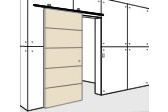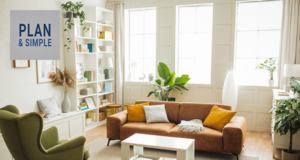
Sliding doors make excellent use of space, and allow significantly larger entryways than conventional hinged doors. ‘Pocketed’ sliding doors even allow you to conceal doors inside wall cavities.

What is a sliding door?
A sliding door consists of one fixed panel attached to two hangers on rollers which slide along a track. The panel slides back and forth to create a door opening. Sliding doors can come in single or double varieties, depending on necessity, space and your own tastes.
Another type of sliding door is the pocket door; in these doors, the panel slides back into a recess in the wall so as to be fully hidden from view when opened. These are popular for hallways and interior rooms.
Stacker doors are another type of sliding door.
How do sliding doors work?
Sliding doors work by sliding a door panel along a set of horizontal rails. Because all the weight of the door is suspended on the rollers attached to the top of the door, weight is a major consideration. If the door is too heavy, it will be difficult to open and may bend off the track. Most sliding doors also have a guide along the bottom to prevent the door from swinging by the rollers. Usually this is accomplished by a groove cut into the base of the door which slides along a plastic strip, although some may also use rollers or bearlings at the bottom of the door.
Sliding doors also feature a stopper at either end to prevent the door from sliding right off the track.
Glass sliding doors typically need to feature visual manifestations – markings to prevent people from carelessly smashing through them by mistake.
Where are sliding doors used?
Sliding doors are very often used as interior doors for rooms and hallways, as well as for showers and wardrobes. They’re particularly popular for indoor use thanks to the large openings they allow, and the small amount of space they require.
Glass sliding doors allow for magnificent views, and are commonly found in backyards across Australia.
As with other glass doors, it’s important to take into account how much heat is likely to be lost through them. Glass is an excellent conductor of heat, so if you’re planning on using glass sliding doors you may also wish to consider how much heat will be lost or gained through them, and options like double glazing, low-e glass or solar window film. Likewise, aluminium is also a fantastic conductor of heat, so for external doors timber frames may be a better choice if you need to control heat.
Are there any variations on sliding doors?
For doors too heavy to support from a top hanging system, the rollers must go underneath the door and the guide rail on top. These types of doors are much more difficult to open, but allow for heavier door construction and materials.
Frames, sizes and panel types (not all sliding doors are made of glass, of course) will vary depending on personal tastes and needs. For larger openings, you may also wish to consider stacker doors which are effectively multi-panelled sliding doors, or bifold doors.
|
Advantages
|
Disadvantages
|





